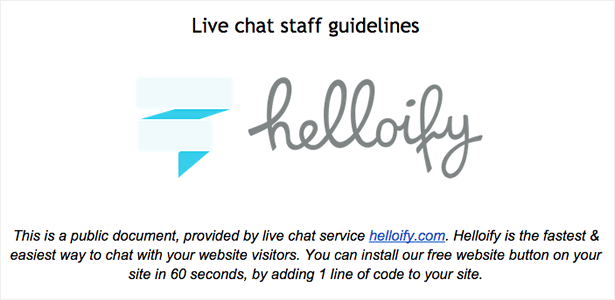In this post I’ll run through some simple guidelines for training staff in how to support customers via live chat. This is intended as a simple starting point.
If you’d like to download the Google Document to use as a procedure in your company, it’s publicly available here. Just chose File / Save a copy to make it your own. The document is structured so you can easily modify any part of the process, particularly the example text provided.
Message length
Generally try to keep messages short. That means less time for the customer to be sitting around waiting for you to type. It’s generally not necessary to only send complete sentences at once. People expect quick replies over and above perfect grammar.
Punctuation
- Start every sentence with a capital letter.
- There is no need to use full stops at the end of sentences, unless there are multiple sentences in your message.
Using the customer’s name
- If the customer has entered their first name, please use their name.
- If we don’t, please ask for it on the first message “Before we start, would you mind letting me know your name? “
- Once we know their name, please use it when you address them. “Thanks [name] I’ll just check for you.”
If you can answer the question within 30 seconds
Please just answer it as the next message you send. If you can’t then read onto the next guideline.
Don’t keep customers waiting more than 60 seconds
If you need some extra time to look up your FAQs to find out an answer for the customer, you need to ask for more time.
Example text:
“Let me check for you”
“I’m just looking into this for you”
If you have to ask for more time more than once, you can use a different version of the text. However if it’s more than 2 minutes we need to get back to them.
“I’m still here, just looking into this”
If it takes more than 2 minutes we need to get back to them later. Send them one of these messages then follow the escalation process.
“Hi [name] I will have to have some extra time to look into this for you.”
Breaking up paragraphs in canned responses
When canned responses have multiple paragraphs, send each paragraph in it’s own message.
You can use Control X to chop out the part you aren’t sending and Control V to paste it and and keep doing that until you have used up the whole message. Or you can paste the response into notepad and copy it across one paragraph at a time.
If you get a question that you don’t understand
If you get a question that has typos or you can’t quite follow the question please say this.
“Sorry I’m not quite following. Can you please rephrase the question?”
More than 3 questions you can’t answer
If this client has asked more than 3 questions that you can’t answer, it might be that the questions are too tricky and they need to be escalated. Example text:
Sorry, your questions are a bit too advanced for me. I think it’s best that I get someone to reply to you via email.
Use of Emoticons
- Use emoticons sparingly when the overall mood of the conversation is friendly.
- Don’t use Emoticons when the customer is reporting a problem or seems unhappy.
- Stick with simple emoticons like :). Don’t use anything that has the potential to be misinterpreted.
Closing out conversations
If you think the conversation is finished, it’s time to close it out so there’s no room for confusion. Example text.
“Is there anything else I can help you with? ”
If they say no, say something like:
“Thanks [name] I’ll close the chat now. Have a nice day.”
How to use these guidelines in your own company
If you are training up your own staff, you can use our Google doc as a starting point to write your own guidelines.
Click here to go to the Google doc and inside it you can choose File / Make a Copy to create your own copy.
If you have any questions please let me know in the comments.
Dan Norris
Latest posts by Dan Norris (see all)
- Use these live chat guidelines to train your team on using live chat software - February 5, 2015
- 5 customer happiness blogs you should be reading - February 4, 2015
- Live chat research – Interview on why people prefer live chat - January 26, 2015


